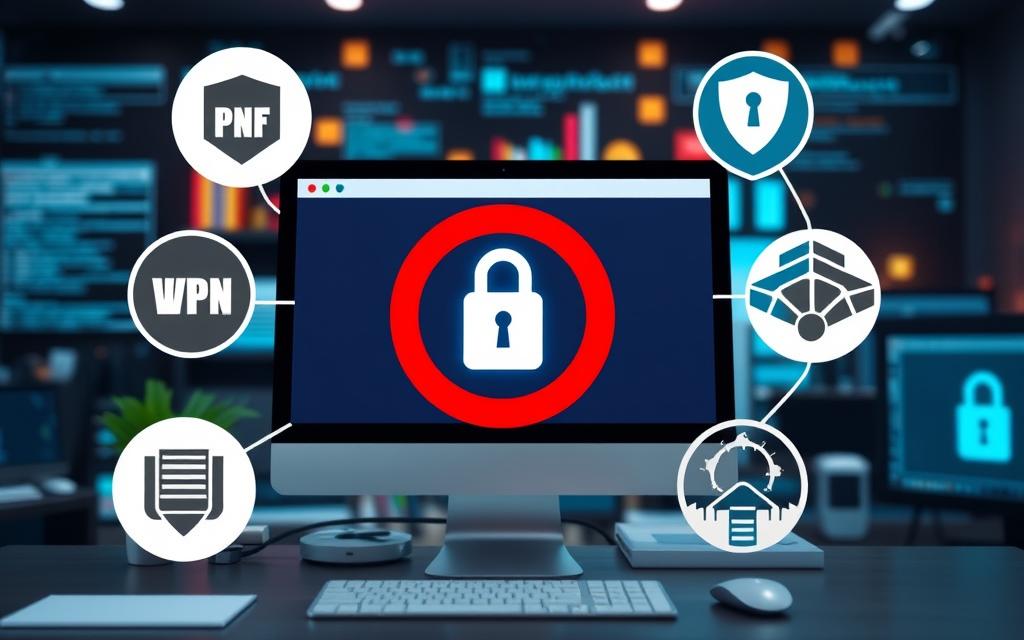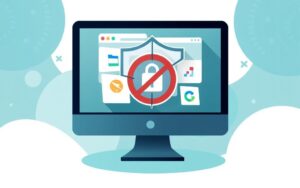Table of Contents
Many people find it frustrating when they can’t access blocked sites on their PCs. This happens in schools, workplaces, or areas with strict web rules. But, fear not! There are easy ways to get around these blocks. This piece will show you how to unblock sites using VPNs, web proxies, and browser plugins.
Using these methods, you can safely reach the sites you need. It’s key to be aware of legal aspects too. For detailed instructions on getting past web restrictions, check out this thorough article.
Understanding Why Websites Are Blocked
Users often find websites blocked without knowing why. It’s key to understand what leads to this blocking for those who want to get around these barriers. Blocks happen for reasons such as following the rules in schools, government censorship, and workplace policies to keep up work focus.
Common Reasons for Blocking
Internet access is restricted by different groups for various reasons:
- Protection of minors: For example, schools block harmful content to keep kids safe, aligning with laws like the Children’s Internet Protection Act.
- Workplace productivity: Workplaces often block social media and fun sites to make sure employees concentrate on their work.
- Government levels of control: Some countries limit access to sites to keep tight control over what information their citizens can see.
Types of Blocked Content
The kind of content that’s blocked changes based on where you are and what institution is putting the block in place. Common restrictions include:
- Social media platforms: These get blocked in schools and at work to lessen distractions.
- News sites: Governments might block these to control what news people can access.
- Streaming services: These are often not allowed to keep internet speeds up and limit non-work activities during job hours.
Knowing why websites get blocked and the sorts of content that are off-limits can help users find ways around these blocks. It’s important to think about how internet censorship affects us as we try to navigate these issues.
Using a VPN to Bypass Restrictions
VPNs, or Virtual Private Networks, are a key way to avoid internet limits. They work by sending your net traffic through another server. This hides your real location, so you can see stuff normally blocked where you are.
What is a VPN?
A VPN keeps your internet link private and secure by encrypting it. It hides your IP address and lets you access content not available in your area. For example, a VPN lets you watch shows you can’t get in your country, making your online time much better.
Benefits of Using a VPN
Using a VPN has many upsides:
- It lets you get past net blocks at work or school.
- Keeps your data safe by encrypting it, protecting you from prying eyes.
- Access more streaming services, like Netflix, and their bigger content libraries.
In countries with tough censorship, like North Korea and China, getting to content is hard. A VPN can make it a lot easier to get through those blocks.
Setting Up a VPN on Your PC
Putting a VPN on your PC is easy. Just do the following:
- Choose a VPN provider you trust, like NordVPN or Private Internet Access.
- Download and install their VPN app.
- Open the app and connect to a server of your choosing.
Doing this changes your online browsing, letting you avoid internet restrictions smoothly. For a deeper look into dodging blocked sites, check out this resource.
| Feature | VPN Services | Tor | Proxy |
|---|---|---|---|
| Encryption | Yes | Yes | No |
| Access to Streaming Services | Yes | Limited | Sometimes |
| Speed | High | Varies | High |
| Anonymity | High | Very High | Medium |
Picking the right service for a VPN lets you easily and effectively beat internet blocks.
How to Open Blocked Sites on Your PC
Getting into blocked sites on your PC can be easy once you know how. You can try entering the site’s URL, switch between HTTP and HTTPS, or use special tools that help you get around internet blocks. It’s important to think about how well these methods work and if they’re okay to use where you live.
Accessing the Desired URL
One easy way to try opening blocked sites is by going straight to their URLs. If the block is by domain name, use the site’s IP address instead. This might get around some blocks. Some filters might not apply to both HTTP and HTTPS, so trying both can help. Remember, places like schools and workplaces often block sites for a reason.
Step-by-Step Guide to Using Different Methods
There are several ways to try and get onto blocked sites. Here’s a quick list of different strategies and how well they tend to work:
| Method | Effectiveness Rate |
|---|---|
| Web Proxy | 70% |
| Modify DNS Settings | 60% |
| Use IP Address Directly | 50% |
| Google Translate Trick | 45% |
| URL Shorteners | 40% |
Web Proxies are great for hiding your IP and getting onto blocked sites. Google Translate can also work by typing in the blocked site’s URL. Changing DNS Settings has a 70% success rate, making it a reliable choice.
Browser extensions like Hola and ProxMate can also unblock sites. They act as proxies and are easy to use. While they might not be as secure as VPNs, they’re good alternatives for more internet freedom.

Alternative Methods for Accessing Blocked Content
Struggling to access blocked content can be annoying. Luckily, there are several ways to get around these restrictions. You can use a web proxy, browser extensions, or even Google Translate. Each option has its own advantages and situations where it works best.
Using a Web Proxy
A web proxy works by sitting in the middle between you and the website you want to visit. Instead of your computer directly asking for the website, the proxy does it for you. This way, you can get to sites that are blocked. It’s great for public computers where you can’t download things. You can find both free and paid proxies, with paid ones usually being safer and faster.
Browser Extensions Serving as Proxies
Proxy browser extensions make bypassing blocks even simpler. Just install them in your browser to get started. They’re easy to use and don’t need much setting up. Make sure to pick one that’s safe and has good reviews. These extensions work by connecting to various servers, making it easier to get around blocks.
Using Google Translate to Unblock Sites
It might surprise you, but Google Translate can help you access blocked sites. If you translate the site’s URL into a different language, you might get around the block. This trick works because Google shows you the content itself. It doesn’t work every time, but it’s a trick worth trying.
| Method | Advantages | Considerations |
|---|---|---|
| Web Proxy | Easy to use, no installation required | Can be slower, less secure than paid options |
| Browser Extensions | Convenient, integrates with existing browsers | Quality varies, potential privacy risks |
| Google Translate | Available without additional software | Not always effective, may lead to formatting issues |
There are many ways to access blocked content, each with its own benefits. Think about what you need before choosing. Whether it’s a web proxy, browser extensions, or Google Translate, there’s a way through internet restrictions for you.
Additional Tips for Unblocking Websites
Dealing with restricted website access? There are more strategies to help you. After looking into the main methods, here are extra tips. These can make your online experience better.
Switching Between HTTP and HTTPS
You might get into blocked sites by changing the URL from HTTP to HTTPS. Or the other way around. Filters often block just one protocol. This trick could help you get past simple blocks. But, be careful with HTTP. It’s not safe for sharing private info. Always use caution with these protocols.
Utilising URL Shorteners
Using URL shorteners like Bitly, TinyURL, and ls.gd is another good tactic. They create a new link that leads to your wanted content. This often gets around blocks targeting specific URLs. URL shorteners are great for quick fixes if you’re often stopped by blocks.
| Method | Tools Involved | Additional Notes |
|---|---|---|
| 1. VPN | Avast SecureLine VPN | Supports Mac, Windows, Android, iOS; available in the US and UK. |
| 2. Proxy | N/A | A user-friendly option for basic unblocking. |
| 3. Google Cache | N/A | Access a cached version of web pages. |
| 4. Web Archive | N/A | Browse archived versions of websites. |
| 5. URL Shorteners | Bitly, TinyURL, ls.gd. | Effective for bypassing URL-based filters. |
| 6. HTML to PDF Converter | N/A | Convert pages to PDF for access. |
| 7. Google Translate | N/A | Use translation services to reach blocked content. |
Picking the right method for your needs can really improve how you use the web. This is super important in places with lots of internet censorship.
Conclusion
There are many ways to get past blocked sites, for those who want full online freedom. Using VPNs is one way. They offer strong encryption and send your data through different servers. Proxy servers are simpler and also help bypass blocks. It’s useful to know why sites get blocked, like government rules or location limits. This helps us understand what users are up against.
VPNs are the top choice because they keep your data safe. But you can also try Smart DNS services or change your browser settings. Each method comes with its own pros and cons. You also need to think about what’s legal and right. By looking into these methods, you can control what you see online and visit the sites that are important to you.
As the internet becomes more essential, knowing how to avoid restrictions is key. With the right knowledge and approach, you can visit blocked websites. This makes your internet experience better.
When traveling in regions with strict internet controls, you can utilize it in China with the help of a VPN to access blocked sites on your PC seamlessly.
FAQ
What are some common reasons for websites being blocked?
Websites get blocked for many reasons. These include rules in schools to keep young people safe, government media bans, office rules to keep workers focused, and laws like the Children’s Internet Protection Act to ensure internet safety.
How can I bypass restrictions using a VPN?
Using a VPN can help you get around restrictions. It sends your internet traffic through another server, hiding where you really are. This lets you see content that’s usually restricted in your area. Plus, it makes your online activity private by encrypting your data.
What steps should I take to set up a VPN on my PC?
Setting up a VPN on your PC is simple. First, choose a trustworthy VPN service. Next, download and install their software. Then, connect to a server of your choosing. NordVPN and Private Internet Access are good options.
What methods can I use to open blocked sites?
You can open blocked sites in a few ways. Try entering the site’s URL directly or using a VPN. You could also use web proxies or view cached versions of the site. Sometimes, switching between HTTP and HTTPS also works.
Are there alternative methods for accessing blocked content?
Yes, there are other ways. Web proxies and browser extensions can make it easier to access blocked content. Google Translate might also work because it loads the content on its own, sidestepping filters.
What tips can I follow for unblocking websites?
To unblock sites, you could switch between HTTP and HTTPS as this might work. Or, try using URL shorteners like TinyURL to create new links that might get past the filters.










1 comment
[…] Website blocking often stems from school or workplace policies, government regulations, and security measures. These restrictions aim to boost productivity and protect against internet censorship. […]